125+ Mental health survey questions to support and empower teams in 2025
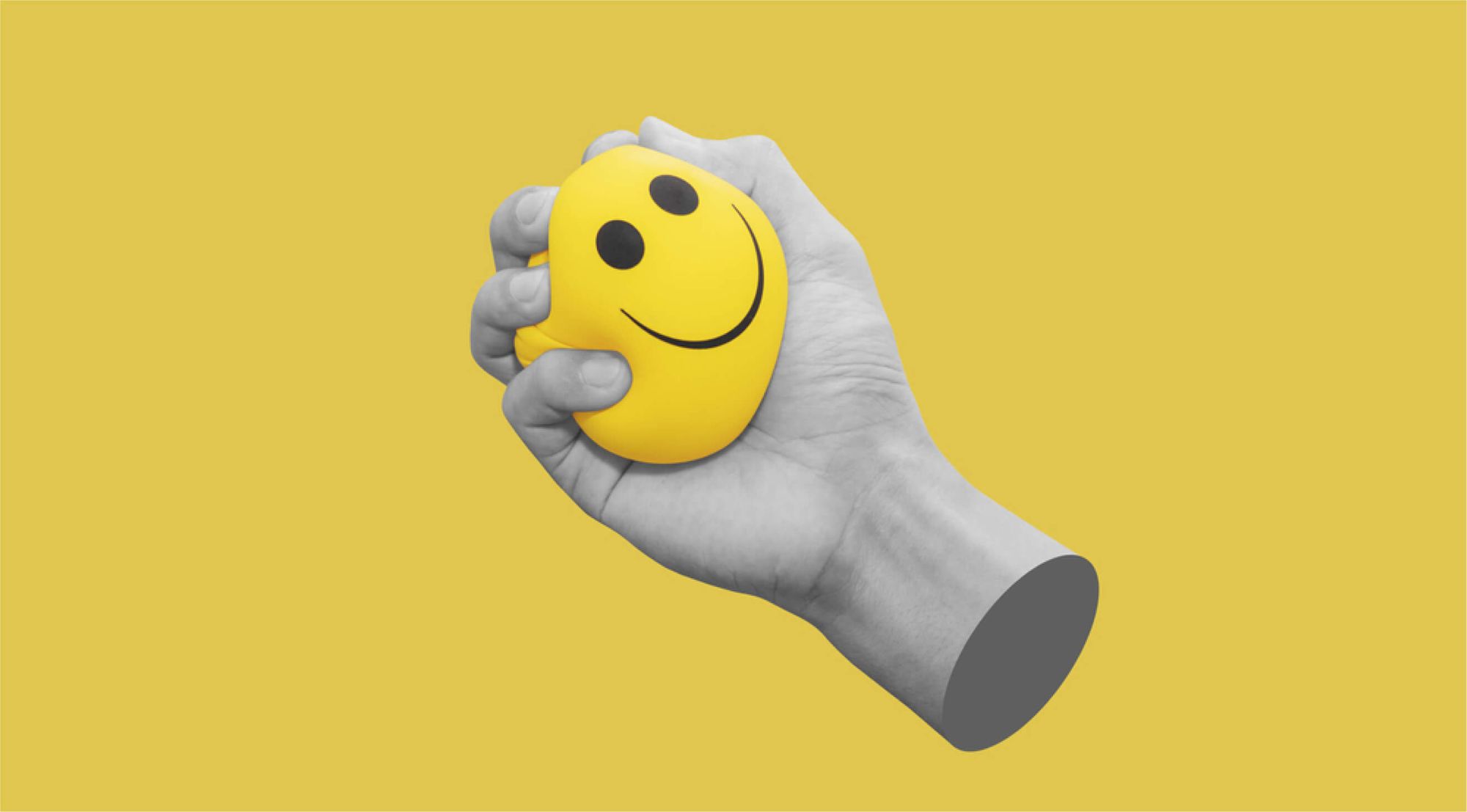
Remember building forts out of couch cushions and bedsheets? You’d stack them just right—sturdy walls, a makeshift roof, maybe a flashlight inside—and suddenly, it was your safe space. Your rules, your refuge. No one questioned why you needed it. It just felt right to have a little corner of calm in a chaotic world.
Now, imagine if we brought that same sense of safety into our workplaces. Not with pillows and blankets—but with mental health survey questions. These aren’t just HR formalities—they're our way of saying, “Hey, is your fort holding up okay?”
In this blog, we’ll unpack the art of asking the right mental health questions—not to pry, but to protect. Because when people feel safe, they don’t just work better—they feel better. And that’s where the real magic happens.
See how mental health survey would look like in CultureMonkey's employee survey tool.
or 125+ Best mental health survey questions for your employees
Blog Highlights

Why are employee mental health surveys important?

Why are employee mental health surveys important?
The importance of mental health in the workplace has never been more evident, especially following the pandemic. Implementing mental health surveys not only helps identify stressors but also provides valuable insights to create supportive work environments.
- Mental health spotlight post-pandemic: The pandemic amplified awareness around mental health issues, bringing them to the forefront. However, mental health challenges have always been present due to pre-existing conditions for many employees.
- Impact on workplace mental health: With 83% of U.S. workers reporting stress-related issues and depression ranking as the third most common workplace problem, organizations can no longer afford to ignore employee well-being.
- Worsened by the pandemic: The pandemic exacerbated mental health issues in the workplace. Mental Health America reports that depression is the third most common workplace issue after stress and family crises, costing over $51 billion in lost productivity and absenteeism, plus $26 billion in treatment costs.
- Financial costs of ignoring mental health: If untreated, workplace depression can have financial implications comparable to diseases like AIDS or heart disease, showing the need for mental health resources.
- Importance of mental health resources: Providing robust mental health resources helps employees manage challenges both at home and work, fostering resilience and career growth.
- Benefits of a positive mental health culture: A workplace that values mental health allows employees to adapt to changing roles, handle stress better, and reach their full potential.
- Creating inclusive workspaces: Data from mental health surveys enables organizations to build inclusive workspaces that support employees at all levels, without discrimination.
- Role of mental health surveys: In today’s dynamic work environment, mental health surveys are essential tools for assessing employee well-being and making informed decisions to support mental health. They help reduce stigma and encourage open dialogue around mental health.
What are the objectives of mental health awareness?
Mental health awareness is critical for fostering a supportive and inclusive environment, both in workplaces and in society. The primary objectives of mental health awareness initiatives are aimed at improving overall well-being and creating a culture that understands and supports mental health challenges. Below are key objectives:
- Reducing stigma: One of the foremost objectives is to diminish the stigma associated with mental health issues. Awareness campaigns work to normalize conversations about mental health, making it easier for individuals to seek help without fear of judgment or discrimination.
- Promoting early intervention: Mental health awareness aims to encourage early recognition of symptoms and prompt intervention. By educating people about the signs and symptoms of mental health issues, these initiatives help ensure that individuals receive the support and treatment they need before their condition worsens.
- Enhancing understanding: Awareness efforts strive to increase general understanding of mental health conditions. This includes educating people about the various types of mental health disorders, their impact, and the importance of mental well-being, much like physical health.
- Providing resources: Another key objective is to ensure that individuals are aware of the resources available to them. This includes information on where to seek help, the types of treatments available, and how to access mental health services.
- Encouraging supportive environments: Mental health awareness also seeks to promote the development of supportive environments, whether in the workplace, schools, or communities. By fostering empathy and understanding, these efforts aim to create spaces where individuals feel safe and supported in addressing their mental health needs.
- Improving overall health: The goal of mental health awareness is to improve overall health by integrating mental health into the broader conversation about well-being. This holistic approach recognizes that mental and physical health are interconnected, and both are essential for a fulfilling life.
Components of mental health in the workplace
Understanding the key components of mental health can help employers frame more effective mental health survey questions for employees and create supportive, resilient workplaces.
- Emotional well-being: This reflects how employees handle emotions such as stress, anxiety, and joy. Including questions about emotional regulation in your employee mental health questionnaire can uncover early signs of burnout.
- Psychological resilience: Resilience is about bouncing back from setbacks. A good mental health questionnaire for employees often assesses coping mechanisms and the ability to manage challenges without long-term negative effects.
- Social connections: The quality of relationships in the workplace has a direct impact on mental health. Strong peer support and team dynamics should be measured through questions about mental health in the workplace to gauge overall team well-being.
- Work-life balance: One of the most critical elements, work-life balance affects productivity and satisfaction. A well-designed employee mental health survey can identify if boundaries between personal and professional life are being respected.
- Sense of purpose: Feeling that one’s work matters improves engagement and mental well-being. When crafting a workplace mental health questionnaire, include prompts that explore the connection between an employee’s role and a larger purpose.
- Access to support: Whether it's HR, managers, or external professionals, access to mental health support is essential. Use mental health in the workplace questionnaire formats to measure awareness and confidence in accessing these resources. These mental health in the workplace survey questions provide insights into what support systems need improvement to strengthen overall well-being through your employee mental health questionnaire.
Types of mental health surveys

In workplace settings, mental health surveys play a key role in assessing and improving employee well-being. There are several types of surveys designed to address specific mental health challenges in professional environments.
- Workplace stress surveys: These surveys identify the sources and levels of stress employees face, focusing on workload, deadlines, and managerial support. They help organizations pinpoint stress triggers and implement strategies to reduce them.
- Burnout surveys: Burnout surveys measure emotional exhaustion, depersonalization, and reduced accomplishment. They provide early indicators of burnout, enabling organizations to take corrective actions before productivity declines.
- Employee satisfaction and engagement surveys: These surveys cover job satisfaction, work-life balance, and emotional engagement. Although broader in scope, they often reveal mental health issues tied to disengagement, helping companies address workplace dissatisfaction.
- Work-life balance surveys: These surveys assess how well employees manage the balance between professional and personal lives. Poor work-life balance can lead to stress and anxiety, and addressing it is crucial for maintaining employee well-being.
- Resilience and coping ability surveys: Resilience surveys evaluate how effectively employees cope with workplace stress. They provide insights into employees’ emotional resilience and the adequacy of available support systems.
Why do we need mental health feedback?
Mental health feedback is essential in any organization as it helps foster a supportive work environment and ensures employees’ well-being. Below are key reasons why mental health feedback is crucial:
- Identify hidden issues early: Mental health issues, such as stress, anxiety, or depression, are not always visible. Regular feedback helps identify these problems before they escalate into more severe conditions. By understanding how employees feel, companies can offer timely interventions.
- Enhance employee engagement: Employees who feel heard and supported are more engaged in their work. Mental health feedback signals that an organization cares about its people, boosting morale, loyalty, and overall productivity. This engagement directly impacts organizational performance and reduces turnover rates.
- Tailor support programs: Gathering mental health feedback allows companies to customize mental health initiatives based on employees’ specific needs. For example, if feedback indicates high levels of workplace stress, organizations can implement stress management programs, flexible work arrangements, or counseling services.
- Improve organizational culture: Mental health feedback contributes to creating a culture of openness and trust. When employees feel safe sharing their mental health concerns, it builds an environment of psychological safety, encouraging collaboration and transparency.
- Track the effectiveness of interventions: Regular mental health feedback enables companies to measure the impact of their mental health programs and adjust them accordingly. It provides insights into whether current initiatives are effective or if new strategies are needed to address emerging issues.

Fostering trust with anonymous surveys
Learn how anonymity transforms mental health surveys at work, download our guide for trusted employee insights.
Work-related risk factors that can harm mental health
Work-related psychosocial risks, like poor work schedules, excessive workloads, and lack of career growth, have a serious impact on employee mental health. Here are the key points, streamlined:
Global impact
12 billion workdays are lost annually due to anxiety and depression, costing the global economy $1 trillion in lost productivity (WHO).
Risk factors
- Under-utilized or under-developed skills
- Excessive workloads
- Lack of control over work structure
- Long or inflexible hours
- Unsafe working conditions
- Harassment, bullying, or violence
- Job insecurity and poor promotion practices
- Conflicting work-home demands
- Lack of recognition, skill development, and career advancement opportunities
- Inadequate workplace culture that enables negative behaviors
- Limited support or supervision
- Exclusion and discrimination
- Under-promotion or over-promotion
- Lack of work-life balance
- Inequitable pay or compensation disparities
- Unclear job roles and responsibilities
- Lack of opportunities for skill development and career advancement
- High levels of job uncertainty due to organizational restructuring or downsizing
- Inadequate access to resources and tools necessary for job performance
- Overbearing micromanagement and excessive surveillance
Solutions
Conduct regular mental health surveys to assess and manage these risks. These surveys can identify harmful conditions and help implement flexible work arrangements, improve workplace culture, and support employee well-being.
How can mental health issues affect work?

On average, people spend 90,000 hours at work, making it essential for mental health to be prioritized in the workplace. Mental health surveys help organizations address these challenges, creating healthier, more supportive environments.
- Lack of engagement: Only 36% of U.S. employees are engaged at work, which lowers motivation, loyalty, and productivity. Engaged employees are more likely to be proactive, contributing positively to organizational success.
- Misaligned communication: 71% of employees feel more productive when connected to colleagues. Without effective communication, remote teams struggle with collaboration, leading to misunderstandings and decreased efficiency.
- Productivity decline: Knowledge-based workers are productive for less than 3 hours a day. Mental health issues further reduce focus and output, affecting both the quality and quantity of work.
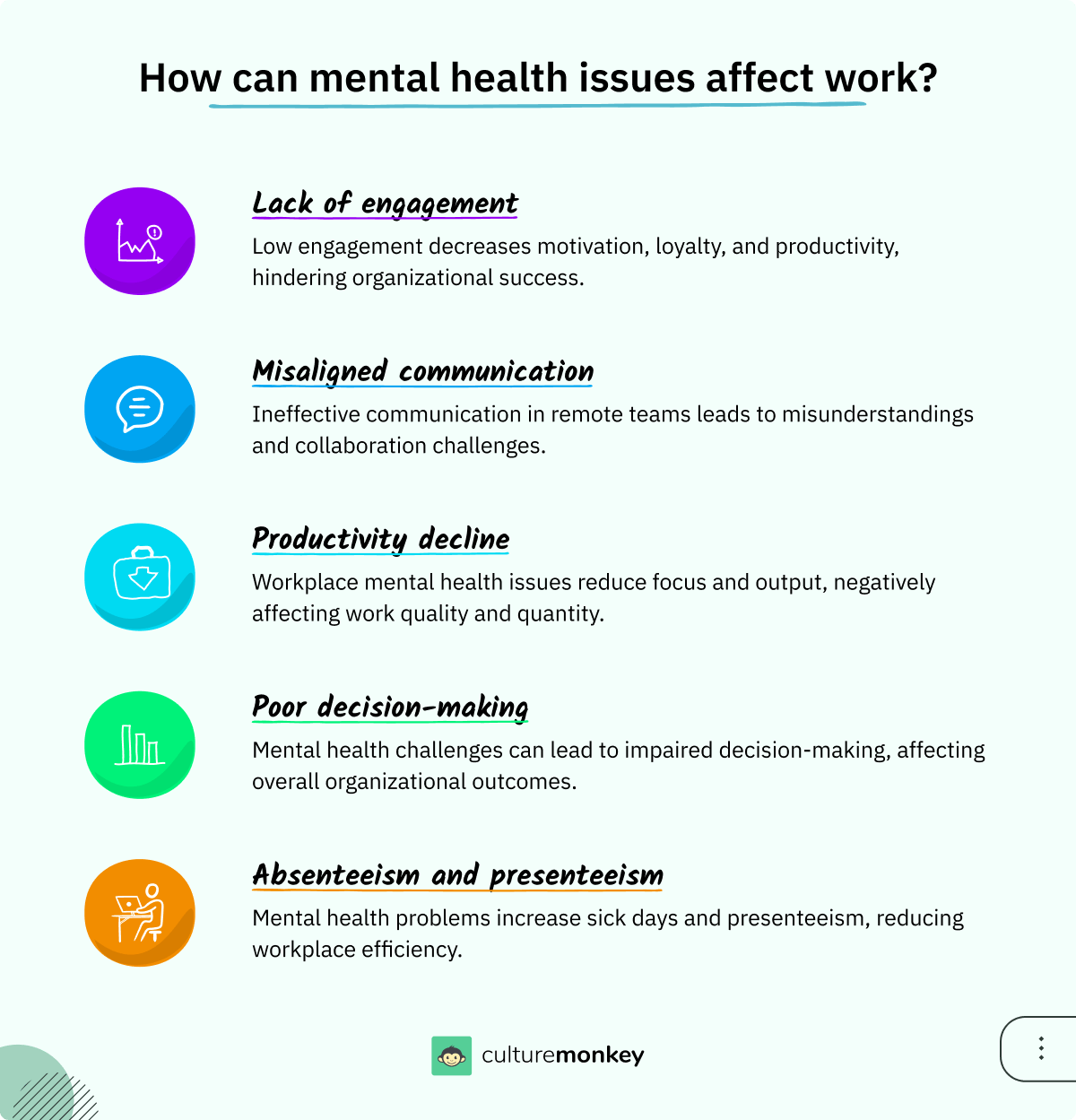
- Poor decision-making: 60% of executives admit bad decisions are as frequent as good ones. Mental health surveys help foster a mentally fit workforce, which leads to improved, informed decision-making.
- Reduced physical functioning: Depression increases the risk of chronic illnesses such as diabetes and heart disease (CDC). Mental and physical well-being are interconnected, with poor mental health often leading to physical health decline.
- Absenteeism and presenteeism: Mental health issues cause more sick days and presenteeism, where employees show up but aren't fully productive. Both reduce overall workplace efficiency and increase healthcare costs.
- Higher turnover rates: Unaddressed mental health leads to higher employee attrition, increasing costs for recruitment and training. This cycle affects long-term organizational stability and growth.
- Impact on team dynamics: Mental health struggles can disrupt team morale, creating conflicts and hampering collaboration. This weakens the overall team’s ability to achieve common goals.
- Legal and compliance risks: Ignoring mental health concerns exposes companies to lawsuits and regulatory fines for not providing a safe work environment. This can also damage the company's reputation.
- Impact on customer relations: Stressed employees offer poor customer service, which leads to dissatisfaction and potential loss of business. Mental well-being directly impacts how employees interact with clients.
- Financial impact: Mental health issues increase operational costs through absenteeism, healthcare expenses, and reduced productivity, ultimately cutting into profitability.
- Stigma and discrimination: A lack of mental health support fosters stigma, making employees reluctant to seek help. This perpetuates a culture of fear and exclusion, reducing employee well-being.
- Reduced creativity: Mental health struggles hinder creative thinking and problem-solving, limiting innovation. This impacts the company’s ability to stay competitive and adaptive in a fast-changing market.
- Compromised leadership: Leaders grappling with mental health challenges may unintentionally demotivate teams. This can lead to decreased morale and overall organizational underperformance.
- Decreased employee loyalty: Employees who feel unsupported in their mental health are more likely to leave. This weakens the organization's long-term loyalty and increases the churn rate.
Examples of mental health discrimination at work
Discrimination against employees with mental health challenges can significantly impact workplace well-being and productivity. It often manifests in subtle ways, leading to a toxic work environment. Here are key examples that illustrate how mental health discrimination can appear at work:
- Unjust work assignments: Employees with disclosed mental health conditions may receive fewer or less meaningful work assignments, leading to a feeling of alienation or being undervalued.
- Limited career advancement opportunities: Employers may overlook promotions or key projects for individuals with a known mental health history, assuming they’re less capable of handling stress or responsibility.
- Negative performance reviews: Employees struggling with mental health issues may face biased performance evaluations, where their symptoms are unfairly interpreted as lack of motivation or poor work ethic.
- Isolation and social exclusion: Colleagues might isolate or avoid engaging with employees who openly discuss their mental health struggles, fostering a culture of stigma.
- Harassment or microaggressions: Subtle comments or jokes that belittle mental health can perpetuate discrimination, causing discomfort and discouraging open discussions on well-being.
- Lack of reasonable accommodations: Denying flexible working hours, breaks, or remote work options necessary for managing mental health reflects discrimination and violates inclusivity policies.
- Retaliation for raising concerns: Employees who voice concerns about mental health may face retaliation, such as job threats or disciplinary actions, which discourages further dialogue and advocacy.
Where does remote working fall short?
Remote working may seem appealing, but it has significant drawbacks. 45% of employees attend more meetings at home, and 40% experience mental exhaustion from video calls (Forbes). Despite initial enthusiasm, many companies struggled to maintain employee well-being and productivity remotely, revealing deeper challenges.
- Mental health crisis: During the pandemic and remote work transition, 75% of employees felt isolated, 57% faced anxiety, and 67% reported higher stress (Harvard Business Review). Mental health issues worsened with social isolation and increased work-related pressure.
- Unfair trade-off: 40% of employees work longer hours remotely, and remote setups can't fully compensate for lost creativity and decision-making efficiency (Business News Daily, NYT). This imbalance often leads to burnout and decreased work satisfaction.
- Lack of work-life balance: 47% of leaders avoid remote work due to its negative impact on well-being, with 77% noting damage to company culture and team-building (Sixth Tone). Remote work blurs boundaries between personal and professional life, making it harder to disconnect.
- Communication challenges: Written messages often lead to misunderstandings, and time zones complicate scheduling and collaboration. These communication barriers can hinder teamwork and delay decision-making processes.
- Limited access to resources: Remote employees struggle with access to essential tools and support, leading to delays and reduced job performance. They also miss the convenience of office infrastructure that supports productivity.
- Reduced sense of belonging: Missing social interactions and in-office dynamics leads to feelings of isolation and detachment from company culture. This disconnection can weaken employee engagement and loyalty.
- Security concerns: Remote work increases risks related to data security and privacy, requiring stronger cybersecurity measures to protect sensitive information. Companies must invest heavily in protecting their systems from cyber threats.
Hybrid work and mental health care of employees
Hybrid work offers flexibility, but it also brings significant mental health challenges. Balancing remote and in-office routines can cause mental fatigue, decision fatigue, and emotional strain. According to the World Health Organization, 15% of working adults had mental health disorders in 2019, and post-pandemic, hybrid work has added more strain.
The constant switching between environments and the increased psychological demands make hybrid work particularly draining for employees. Frequent workplace mental health questionnaire assessments can help organizations identify and address these challenges effectively.
- Surveys help pinpoint specific stressors in the hybrid model, such as managing work-life boundaries and increased decision fatigue. This allows organizations to take targeted action to reduce these pressures.
- Frequent mental health assessments track emotional and psychological well-being, highlighting areas where employees may struggle with the shift between home and office environments.
- Mental health surveys can reveal gaps in communication, especially for remote workers. Employers can then implement better strategies for collaboration and connection, reducing feelings of isolation.
- Surveys identify how hybrid work impacts engagement levels, enabling organizations to tailor solutions that improve employee satisfaction and overall productivity.
- By collecting data on mental health issues, companies can customize resources and interventions, offering tailored mental health programs and mental health questionnaire for employees that address the unique challenges of hybrid work.
How can employers support employees' mental health?

Millions of employees suffer from mental illness annually, impacting their productivity and attendance. In the U.S., 1 in 5 adults experience mental illness, and 86% of employees receiving treatment for depression report improved work performance (National Alliance on Mental Illness, National Library of Medicine). Companies can use mental health surveys to understand and address these challenges effectively.
- Understand employees' mental health through useful anonymous feedback from mental health surveys and training.
- Include mental health coverage as part of employees' healthcare plan.



If you do not treat people with the respect they deserve, do not expect any kind of commitment to your productivity goals and target.
Founder and CEO
Sorbet Group
- Implement EAP (employee assistance program to support workplace mental health services.
- Promote well-being among employees through wellness and fitness goals.
- Encourage open communication by creating a supportive environment where employees feel safe discussing their mental health without fear of stigma or discrimination.
- Provide flexible work arrangements, such as remote work options or adjustable hours, to help employees manage stress and maintain a better work-life balance.
How do you evaluate employee mental health?

Evaluating employee mental health questionnaire is a vital aspect of creating a supportive and productive work environment. Here are five effective ways to assess and monitor the mental well-being of your team:
- Mental health surveys: Conduct regular, anonymous mental health surveys to gather employee feedback on stress, job satisfaction, and work-life balance. This provides insights into overall well-being and areas needing support.
- One-on-one check-ins: Schedule regular pulse checks between managers and employees, fostering an open environment where employees can comfortably discuss mental health challenges and receive support.
- Employee Assistance Programs (EAPs): Encourage the use of EAPs, which provide confidential counseling and resources for personal and work-related mental health issues. Ensure employees are aware of these available services.
- Absenteeism and presenteeism: Monitor for increased sick days or reduced productivity, as these can signal mental health concerns. Address any sudden changes promptly with appropriate support.
- Training and education: Offer mental health training to both employees and managers to raise awareness, reduce stigma, and equip them with tools for managing stress and recognizing mental health warning signs.
Mental health survey template
A thoughtfully designed mental health survey template can uncover critical insights about your workforce’s well-being. By using templates tailored to specific workplace needs, HR leaders can collect actionable data to foster a supportive environment and address key challenges impacting mental health.
- Customizable questions: An effective mental health survey template offers flexible, customizable questions that align with the unique needs of your organization. Tailored questions make it possible to delve deeper into employee stressors, work-life balance, and overall satisfaction, ensuring meaningful responses.
- Clear structure and flow: A well-structured mental health survey template should be easy to understand, with logically grouped questions. This encourages higher completion rates and honest feedback. Simple, targeted questions reduce response fatigue and increase the accuracy of insights gathered.
- Diverse question types: To gather comprehensive data, use varied question formats such as multiple-choice, open-ended, and scaled responses. Incorporating diverse formats into your mental health survey template helps capture both quantitative and qualitative data, offering a holistic view of employee sentiment.
- Anonymity and confidentiality: A strong mental health survey template guarantees anonymity, creating a safe space for employees to share openly. When confidentiality is ensured, employees are more likely to provide authentic responses, enhancing the reliability of survey findings.
- Actionable insights: The ultimate goal of any mental health survey template is to generate actionable insights. Collecting data is just the first step—use findings to create targeted initiatives, policies, or programs that directly address the well-being of your workforce and improve mental health outcomes over the long term.
A robust mental health survey template is essential for organizations looking to foster a supportive culture and make meaningful, lasting changes based on employee needs. By regularly updating and optimizing the template, companies can remain proactive in addressing emerging mental health trends and challenges.
How to ask about mental health in a survey?
When creating a survey to assess mental health, it's crucial to approach the topic with sensitivity and clarity. Asking the right questions can provide valuable insights while ensuring employees feel comfortable and supported. Below are key strategies to consider:
- Offer a range of responses: Provide a spectrum of answers, such as a Likert Scale (e.g., scale of 0–10), to capture the nuances in employees' experiences and feelings. This allows for more detailed insights.
- Include open-ended questions: Incorporate open-ended questions that invite employees to elaborate on their experiences or concerns. This can uncover issues that may not be addressed by closed-ended questions alone.
- Focus on specific areas: Ask questions about specific aspects of work that impact mental health, such as workload, work-life balance, and team dynamics. This helps identify particular areas that may require attention.
- Provide context: Explain why you are asking these questions and how the data will be used. This transparency helps build trust and shows that the organization is committed to making positive changes.
- Allow for opt-out: Give employees the option to skip any questions they do not feel comfortable answering. This respect for personal boundaries can increase overall participation.
- Incorporate regular check-ins: Add mental health check in questions to create ongoing dialogue and identify changes over time.
- Use varied question formats: Combine mental health poll questions, employee wellbeing survey questions, and both structured and open mental health questions to ask employees for well-rounded insights.
- Ensure clarity and purpose: When planning a mental health at work questionnaire or workplace mental health survey, consider how to ask about mental health in a survey and use each mental health assessment for employee or survey for mental health with clear intent.
Best practices for creating a mental health survey

When creating a mental health survey, it's important to implement best practices that ensure the survey is both effective and sensitive to respondents' needs. Here are some unique, detailed tips to guide the creation process:
- Pilot test: Run a small test with a sample group to identify any unclear or biased questions before full deployment.
- Maintain a neutral tone: Avoid judgmental phrasing. Use neutral language to encourage honest feedback.
- Use various question types: Combine multiple-choice, Likert scales, and open-ended questions for a balanced mix of quantitative and qualitative data.
- Focus on recent experiences: Include time-bound questions (e.g., reflecting on the past week) to capture actionable, current insights.
- Offer follow-up support: Provide an option for respondents to access support or resources after completing the survey, showing commitment to their well-being.
- Ensure anonymity: Guarantee confidentiality to encourage honest responses and protect participants’ privacy.
- Use clear, simple language: Avoid complex terms. Keep questions straightforward to ensure understanding across all education levels.
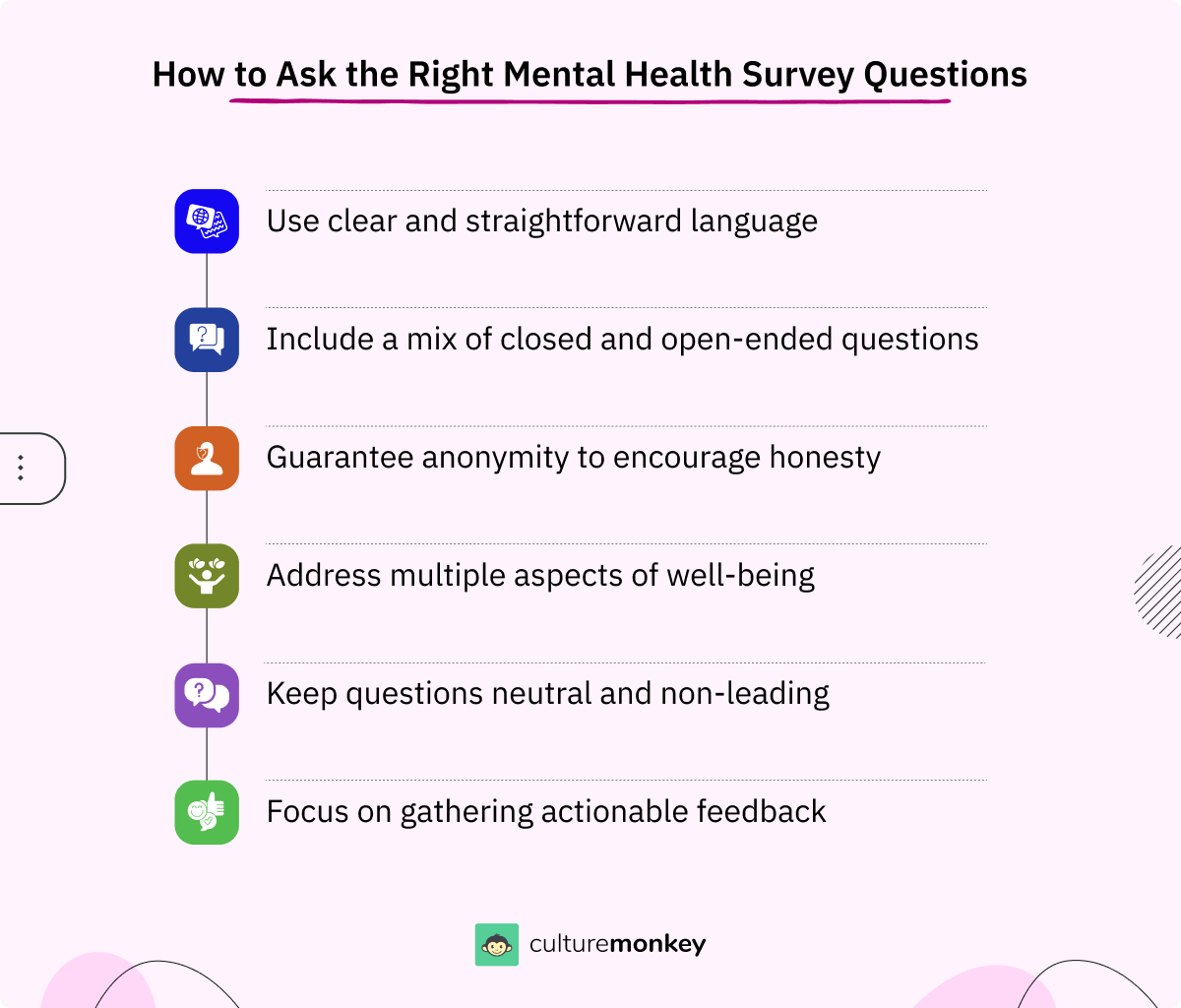
Types of questions to include in a mental health survey

When creating a mental health survey in the workplace, it’s crucial to include a diverse range of questions that address different aspects of employee well-being. Here are the key types of questions to consider:
- Stress and anxiety levels: Include questions that assess the intensity of work-related stress and anxiety. For example, “On a scale of 1 to 10, how often do you feel stressed during the workweek?” This helps identify high-stress levels that may require immediate intervention.
- Work-life balance: Ask about how employees manage their professional and personal lives. A question like, “Do you feel you have enough time to unwind after work?” reveals if employees are struggling to maintain balance, which can lead to burnout if not addressed.
- Support systems: It’s important to gauge whether employees feel supported in their mental health. A question such as, “Do you feel comfortable discussing mental health concerns with your supervisor or HR?” helps determine whether existing support mechanisms are effective.
- Emotional exhaustion: Include questions that assess emotional fatigue, such as, “How often do you feel emotionally drained at the end of your workday?” This helps identify early signs of burnout and emotional exhaustion.
- Coping mechanisms and resources: Ask employees if they are aware of and use available resources, such as Employee Assistance Programs (EAPs). For example, “Are you aware of the mental health resources provided by the company?” ensures employees are informed about support options.
100+ Best mental health survey questions for your employees

- How would you rate your manager's support in completing your work? [scale of 0–10]
- How would you rate your manager's skill for maintaining honest two-way communication within the team? [scale of 0–10]
- How well do you feel that your manager has created a working environment where you can openly discuss mental health within the team? [scale of 0–10]
- How would you rate your work-life balance? [scale of 0–10]
- How would you rate your work stress level? [scale of 0–10]
- How often do you feel under pressure since you can't meet the demands of your day-to-day job? [scale of 0–10]
- What are your energy levels like after working hours? [scale of 0–10]
- Rate your overall mood at work, 10 being extremely happy and 0 being unhappy. [scale of 0–10]
- How strongly do you believe that our organization aids in stress management? [scale of 0–10]
- How strongly do you believe that our organization handles disagreements very professionally? [scale of 0–10]
- How often do you procrastinate during working hours? [scale of 0–10]
- How strongly have our organization's mental health initiatives positively impacted you? [scale of 0–10]
- Compared to your onboarding date, how positively has your mental health changed due to the organization's mental health initiatives?
- How strongly do you believe that there is room for our organization to support your work-life balance and mental health? [scale of 0–10]
- How would you rate your physical health? [scale of 0–10]
- Over the last 12 months, how do you rate your overall mental health? [scale of 0–10]
- How often do you feel extreme hopelessness or sadness? [scale of 0–10]
- How often do you feel calm and peaceful during working hours? [scale of 0–10]
- How frequently do you feel anxious due in the workplace due to work deadlines?
- How would you rate your physical fitness level compared to others of your age? [scale of 0–10]
- Have you ever consulted a therapist in the recent past? [Yes or No]
- How satisfied are you with your relationship with your colleagues? [scale of 0–10]
- How do you rate your energy levels at the end of the day? [scale of 0–10]
- How often do you follow any lifestyle changes to stay mentally fit? [scale of 0–10]
- What are the other ways our company can help you with work-life balance and mental health? [open-ended question]
- How comfortable are you discussing mental health concerns with your supervisor? [scale of 0–10]
- Do you feel that your workload is manageable? [scale of 0–10]
- How often do you feel that your contributions are valued by the organization? [scale of 0–10]
- How effective do you find the mental health resources provided by the organization? [scale of 0–10]
- How often do you take breaks to manage stress during work? [scale of 0–10]
- How supported do you feel by your peers when dealing with stress? [scale of 0–10]
- How often do you feel that you can maintain a healthy work-life balance? [scale of 0–10]
- How confident are you in accessing mental health resources when needed? [scale of 0–10]
- How well do you feel the company promotes mental well-being? [scale of 0–10]
- How would you rate the organization’s overall commitment to mental health? [scale of 0–10]
- Do you feel that mental health is prioritized in our company culture? [Yes or No]
- How frequently do you experience stress due to unclear job expectations? [scale of 0–10]
- How confident are you in addressing mental health concerns with HR? [scale of 0–10]
- How often do you feel overwhelmed by your workload? [scale of 0–10]
- How supported do you feel in maintaining a healthy work-life balance? [scale of 0–10]
- How would you rate your ability to focus during the workday? [scale of 0–10]
- How frequently do you feel burnt out from work? [scale of 0–10]
- Do you feel that your mental health needs are recognized and respected by the company? [Yes or No]
- How often do you feel appreciated for your work by your manager? [scale of 0–10]
- How frequently do you feel you need more mental health resources at work? [scale of 0–10]
- How do you rate your current level of job satisfaction? [scale of 0–10]
- How often do you feel like your workload is evenly distributed within your team? [scale of 0–10]
- How much control do you feel over your work schedule? [scale of 0–10]
- How comfortable are you taking time off for mental health reasons? [scale of 0–10]
- How often do you feel isolated while working remotely? [scale of 0–10]
- How would you rate the communication of mental health resources within the company? [scale of 0–10]
- How effective are your coping mechanisms for stress at work? [scale of 0–10]
- How often do you feel overwhelmed by conflicting work and home responsibilities? [scale of 0–10]
- How satisfied are you with the level of flexibility in your work hours? [scale of 0–10]
- How well do you feel the company addresses work-related stress? [scale of 0–10]
- How supported do you feel when balancing personal and professional commitments? [scale of 0–10]
- How often do you feel mentally recharged after the weekend? [scale of 0–10]
- How confident are you in discussing workload issues with your manager? [scale of 0–10]
- How frequently do you feel disconnected from your team due to remote work? [scale of 0–10]
- How do you rate your emotional well-being at work? [scale of 0–10]
- How often do you feel encouraged to take mental health days? [scale of 0–10]
- How satisfied are you with the company’s efforts in promoting a healthy work environment? [scale of 0–10]
- How frequently do you feel you have adequate time to complete your tasks? [scale of 0–10]
- How comfortable are you sharing feedback about your mental health with HR? [scale of 0–10]
- How often do you feel physically drained from your work? [scale of 0–10]
- How effective do you find the company’s response to mental health concerns raised by employees? [scale of 0–10]
- How well do you feel the organization supports your professional growth and mental well-being? [scale of 0–10]
- How confident are you in the company’s leadership when it comes to addressing mental health concerns? [scale of 0–10]
- How frequently do you feel work deadlines impact your sleep patterns? [scale of 0–10]
- How well do you feel the organization promotes a culture of work-life balance? [scale of 0–10]
- How often do you feel encouraged to engage in wellness or relaxation activities during work hours? [scale of 0–10]
- How supported do you feel in managing workplace conflicts that may affect your mental health? [scale of 0–10]
- How frequently do you feel disconnected from the company's mission or values? [scale of 0–10]
- How effective do you find the company's training programs on mental health and stress management? [scale of 0–10]
- How often do you feel work-related stress impacts your personal relationships? [scale of 0–10]
- How likely are you to recommend the company’s mental health initiatives to a friend or colleague? [scale of 0–10]
- How effective do you find your current methods for managing work-related stress? [scale of 0–10]
- How often do you feel your workload is fair and manageable? [scale of 0–10]
- How comfortable are you providing feedback on company policies affecting mental health? [scale of 0–10]
- Do you feel you have access to sufficient resources and support services to support your mental well-being? [Yes or No]
- How frequently do you experience feelings of burnout? [scale of 0–10]
- How confident are you that your mental health feedback is taken seriously by management? [scale of 0–10]
- How often do you feel isolated due to your work environment? [scale of 0–10]
- How satisfied are you with the flexibility of your work schedule? [scale of 0–10]
- How effective do you find communication about mental health resources within the company? [scale of 0–10]
- How supported do you feel in achieving work-life balance? [scale of 0–10]
- How frequently do you feel mentally drained by the end of the workweek? [scale of 0–10]
- How well do you think the company addresses job-related anxiety? [scale of 0–10]
- How often do you feel comfortable discussing mental health challenges with HR? [scale of 0–10]
- How accessible are mental health resources when you need immediate support? [scale of 0–10]
- How satisfied are you with the company’s efforts to reduce workplace stress? [scale of 0–10]
- How often do you feel empowered to make decisions about your workload? [scale of 0–10]
- How effectively do team meetings reduce work-related tension? [scale of 0–10]
- How comfortable are you taking mental health days when needed? [Yes or No]
- How well do you feel the company handles conflict resolution? [scale of 0–10]
- How often do you feel motivated to engage with your team? [scale of 0–10]
- How effective are your coping mechanisms for managing work stress? [scale of 0–10]
- How frequently do you experience clarity in job expectations? [scale of 0–10]
- How often do you have access to professional development opportunities related to mental health? [scale of 0–10]
- How supported do you feel in managing personal challenges that impact work? [scale of 0–10]
- How confident are you in speaking up about stressors that affect your job performance? [scale of 0–10]
- How often do you feel your mental health is recognized as a priority in company culture? [scale of 0–10]
- How frequently do you feel mentally refreshed after taking a break during work? [scale of 0–10]
- How comfortable are you discussing personal challenges that affect your work with your manager? [scale of 0–10]
- How often do you feel aligned with your team’s values and purpose? [scale of 0–10]
- How well do you feel your mental health needs are considered during project planning or workload assignment? [scale of 0–10]
- How often do you feel emotionally supported during challenging times at work? [scale of 0–10]
- How effective do you find peer support in helping you manage work-related stress? [scale of 0–10]
- How regularly do you engage in wellness programs offered by the organization? [scale of 0–10]
- How confident are you that your manager understands the signs of burnout? [scale of 0–10]
- How often do you feel mentally prepared to start your workday? [scale of 0–10]
- How satisfied are you with the availability of mental health resources across departments or locations? [scale of 0–10]
- How frequently do you receive reminders or prompts to take care of your mental health? [scale of 0–10]
- How often do you find the workload evenly distributed among team members? [scale of 0–10]
- How well do you think the leadership communicates the importance of mental health? [scale of 0–10]
- How often do you use mindfulness or relaxation techniques during the workday? [scale of 0–10]
- How comfortable are you declining work tasks when your mental health is at risk? [scale of 0–10]
- How often does your role allow you time for self-reflection and emotional rest? [scale of 0–10]
- How well do you understand the company’s policies around mental health leave? [scale of 0–10]
- How supported do you feel after returning from a mental health-related absence? [scale of 0–10]
- How likely are you to participate in future mental health training sessions? [scale of 0–10]
- How frequently do you experience compassion from leadership during high-stress periods? [scale of 0–10]
- How aware are you of the mental health services available through your benefits package? [scale of 0–10]
- How often do you receive constructive feedback that improves your emotional well-being at work? [scale of 0–10]
- How connected do you feel to your team during collaborative projects? [scale of 0–10]
- How often do you feel your opinions are heard without judgment? [scale of 0–10]
- How helpful do you find leadership in modeling mentally healthy behaviors? [scale of 0–10]
- How confident are you that leadership will act on the results of this survey? [scale of 0–10]

Great minds foster great teams
Our guide provides key questions designed to assess stress, well-being, and work-life balance, helping you create a thriving workplace for mental wellness.
15 Wellbeing survey questions to ask your employees at workplace
- How satisfied are you with the support you receive from your manager in completing your work? [scale of 0–10]
- Do you feel that your manager effectively encourages honest two-way communication within the team? [Yes or No]
- How comfortable do you feel discussing mental health within your team, thanks to your manager's efforts? [scale of 0–10]
- What is your current perception of your work-life balance? [scale of 0–10]
- How well do you manage your work-related stress levels? [scale of 0–10]
- How frequently do you experience pressure due to the demands of your job? [scale of 0–10]
- Rate your overall energy levels after working hours. [scale of 0–10]
- On a scale from 0 to 10, how satisfied are you with your mood at work?
- In your opinion, to what extent does our organization support stress management? [scale of 0–10]
- How professionally do you believe our organization handles disagreements? [scale of 0–10]
- How often do you find yourself procrastinating during work hours? [scale of 0–10]
- To what degree have our organization's mental health initiatives positively impacted you? [scale of 0–10]
- How would you rate the changes in your mental health since joining our organization?
- In your view, how effectively does our organization support your work-life balance and mental health? [scale of 0–10]
- How satisfied are you with your relationships with colleagues? [scale of 0–10]

Building a healthy team starts here
Get 10 mental health survey activities for teams to enhance well-being and foster a supportive, engaged workplace.
Best practices for distributing mental health surveys

Distributing mental health surveys in the workplace requires careful planning to maximize participation and ensure data integrity. Here are the best practices for distributing such surveys:
- Choose the right timing: Timing is crucial when distributing mental health surveys. Avoid busy periods like project deadlines or holidays. Instead, distribute surveys during less hectic times to ensure employees are not overwhelmed and can thoughtfully respond.
- Ensure anonymity and confidentiality: To encourage honest responses, guarantee anonymity and confidentiality. Use platforms that anonymize data, ensuring that employees feel safe sharing sensitive mental health information without fear of repercussions.
- Communicate the purpose clearly: Explain the survey’s purpose upfront. Inform employees how their feedback will be used and emphasize that the goal is to improve mental health resources and support systems. Transparent communication fosters trust and encourages participation.
- Use multiple channels for distribution: Offer flexible options by distributing surveys through various channels such as email, mobile apps, or internal portals. This ensures that remote, hybrid, and in-office employees can access the survey easily, leading to higher response rates.
- Send friendly reminders: Follow up with gentle reminders, especially as the deadline approaches. Be careful not to overwhelm employees with frequent messages, but do encourage participation with clear, concise reminders.
- Make participation optional: Participation should always be voluntary. This respects employees' boundaries, especially when discussing mental health, and helps avoid any pressure or discomfort.



When you put people first and then surround them with processes and disciplines that recognize their efforts, performance will soar.
Founder
How Leaders Lead
How to measure workplace mental health?
Measuring mental health in the workplace requires a thoughtful blend of qualitative and quantitative methods to truly capture the emotional and psychological state of your workforce.
- Use a workplace mental health survey: Start with a structured mental health at work questionnaire that covers topics like stress, engagement, and support. This offers a data-driven baseline for improvement.
- Incorporate employee wellbeing survey questions: Use targeted employee wellbeing survey questions to assess how employees perceive their mental health and the effectiveness of existing support systems.
- Ask mental health check-in questions regularly: Short and frequent mental health check in questions can be used during team meetings or 1:1s to monitor mood and flag early signs of mental distress.
- Design thoughtful mental health discussion questions: Facilitate open conversations using carefully curated mental health discussion questions that create psychological safety and promote honest feedback.
- Leverage psych evaluation questions and mental wellness questionnaire formats: Use psych evaluation questions and a comprehensive mental wellness questionnaire to assess emotional resilience, focus, and mood stability.
- Customize survey questions for mental health initiatives: Tailor your survey questions for mental health or mental health poll questions to specific campaigns or seasons. Tools like a mental health assessment for employee or a short survey for mental health can help.
Consider how to ask about mental health in a survey to ensure sensitivity while gathering valuable insights through mental evaluation questions, mental health questions to ask employees, and exploratory mental health research questions.
How to interpret mental health survey results
Effectively interpreting mental health survey results is key to transforming data into actionable insights. Proper interpretation helps organizations understand their workforce's needs, pinpoint areas for improvement, and create meaningful change. Here’s a step-by-step approach:
- Segment data by demographics
Break down responses by factors such as department, role, or location. This can highlight specific groups facing unique mental health challenges and help target interventions more precisely. - Identify patterns and trends
Look for recurring themes or consistent feedback over multiple survey cycles. Identifying these patterns reveals chronic issues, such as high stress levels or lack of work-life balance, which may require long-term solutions. - Prioritize high-impact issues
Use response frequency and severity ratings to prioritize issues with the greatest impact on employee well-being. Focusing on high-priority areas ensures resources are allocated where they’re most needed. - Cross-reference with other metrics
Compare survey results with performance metrics, absenteeism rates, or employee turnover. This cross-referencing can uncover the root causes of productivity declines or retention challenges. - Assess employee perceptions
Pay attention to how employees perceive mental health support and communication within the organization. Discrepancies between intended policies and actual employee experiences may highlight gaps to address. - Develop and share action plans
Share findings transparently with employees, outlining clear, data-driven plans for addressing identified issues. Engaging employees in this process reinforces trust and demonstrates commitment to improving workplace mental health.
How to prioritize employee mental health with pulse surveys?
Prioritizing employee mental health through pulse surveys involves regular, short, and focused assessments to gauge the mental well-being of your workforce. Below are key steps to ensure pulse surveys effectively support mental health initiatives:
- Segment survey responses by team or department: By breaking down survey data by department or team, organizations can identify specific areas where mental health support is most needed. This allows for targeted interventions where the need is greatest, rather than a one-size-fits-all approach.
- Introduce mental health check-in questions: Incorporate check-in questions that focus on an employee’s emotional and psychological state in real-time. For example, "On a scale of 1-10, how supported do you feel by your team this week?" These quick, reflective questions can provide immediate insights into employees' day-to-day mental health.
- Offer flexible participation methods: Allow employees to complete pulse surveys in formats that suit them best, whether it's via email, mobile app, or anonymous link. This flexibility increases participation rates, particularly for remote or hybrid workers who may feel more comfortable providing feedback through certain channels.
- Integrate pulse survey results with mental health resources: Link survey results directly to mental health resources or support services. For instance, if high stress levels are detected in the pulse survey, immediately offer links to counseling services, stress management resources, or wellness programs within the survey follow-up.
- Measure changes in mental health over time: Use pulse surveys to track mental health trends, focusing on changes in employee well-being over weeks or months. This longitudinal data helps organizations assess the impact of interventions and adjust strategies accordingly for continuous improvement.
How CultureMonkey can help you run mental health surveys with ease
CultureMonkey empowers organizations to create comprehensive mental health surveys by offering tools that enhance engagement and actionable insights. With user-friendly features like heatmaps, sentiment analysis, and AI-driven recommendations, it simplifies understanding and acting on employee feedback.
- Heatmaps: Heatmaps simplify visualizing survey results, revealing mental health trends by department, gender, location, and manager. This clarity helps identify patterns, pinpoint areas needing support, and guide tailored interventions effectively.
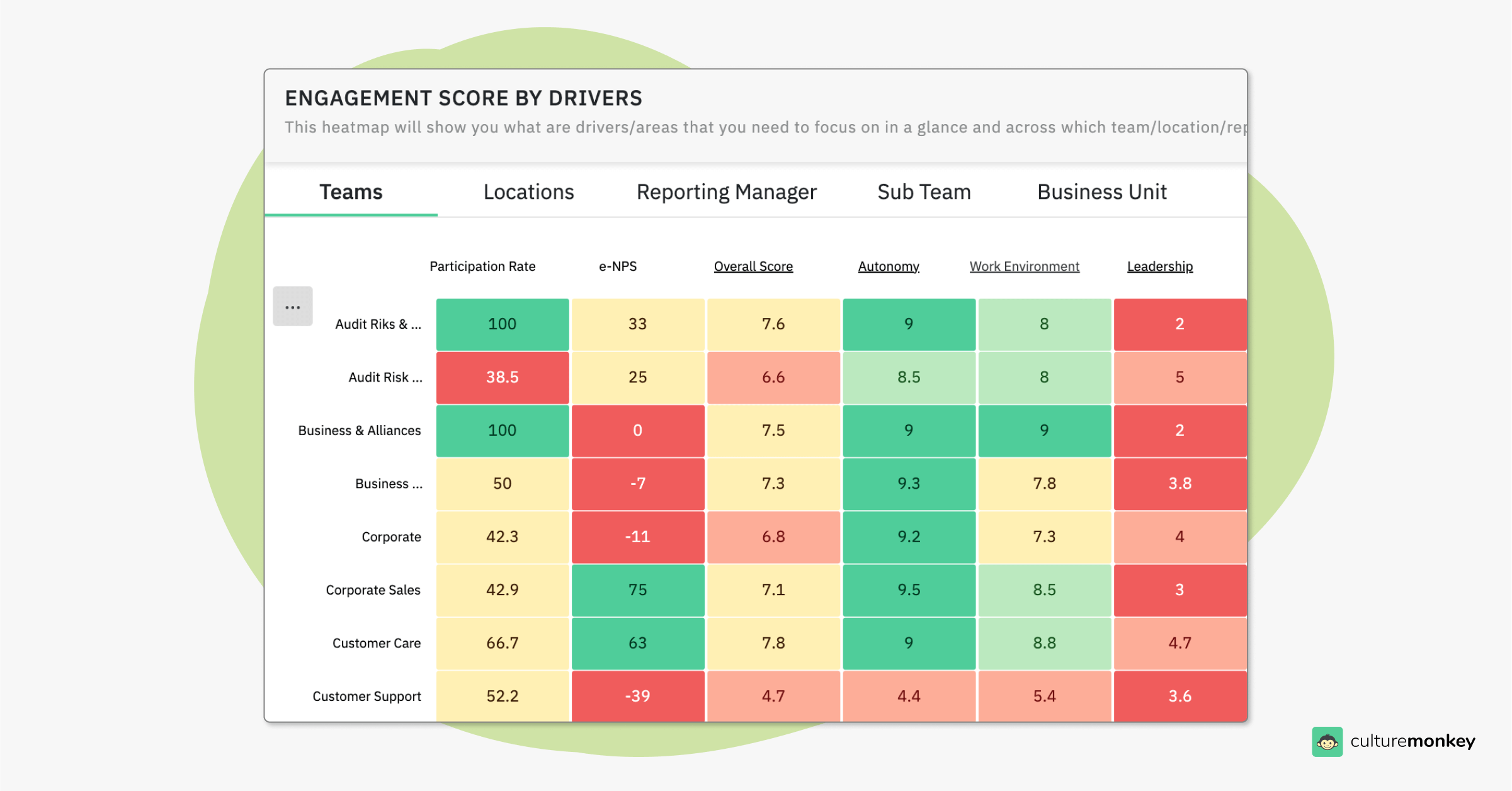
- Survey templates: CultureMonkey’s customizable survey templates offer a starting point tailored to your needs, making it easy to address diverse mental health topics. This flexibility ensures questions resonate deeply with employees, driving more meaningful and accurate insights.
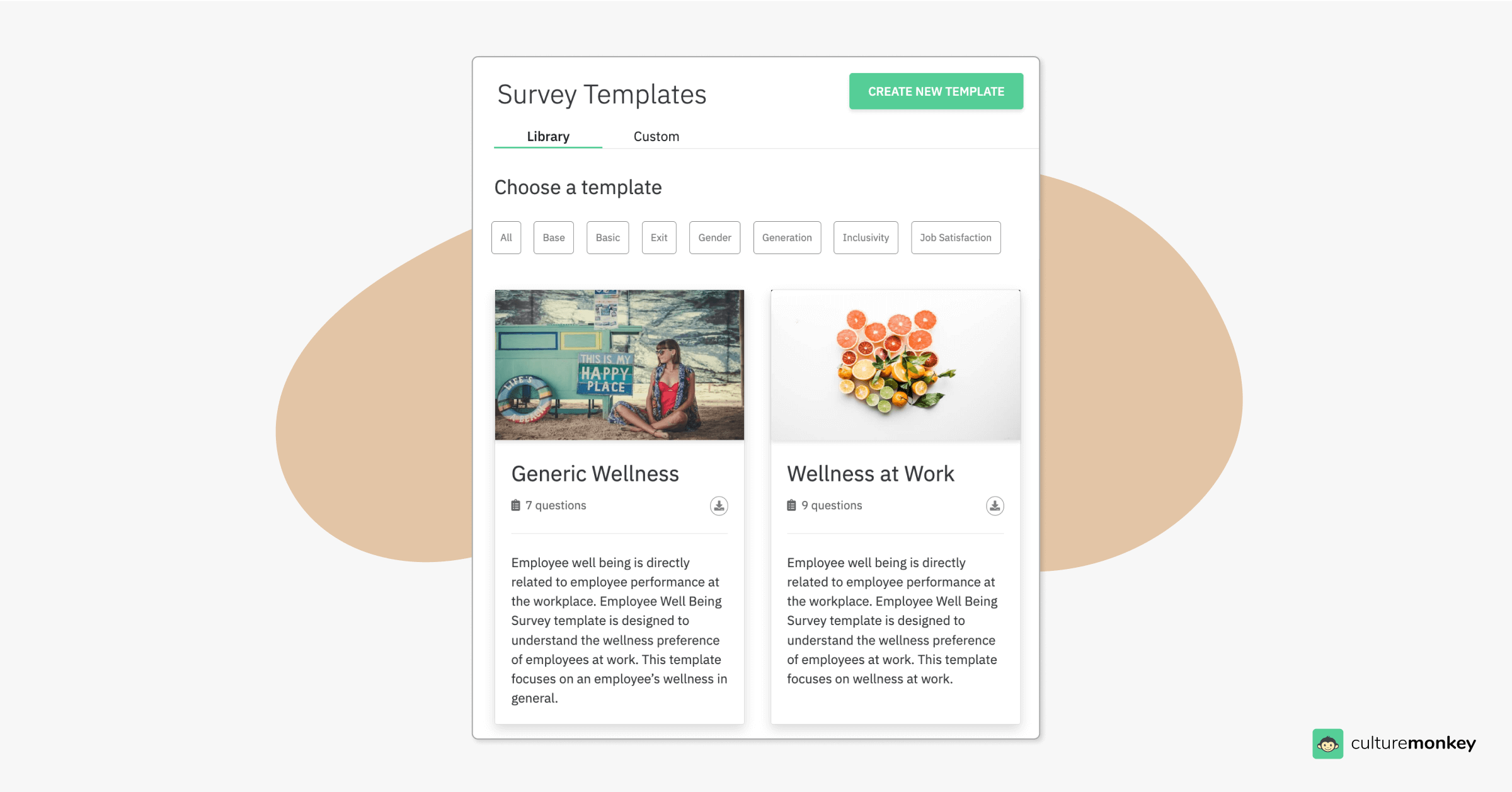
- Likert scale: CultureMonkey’s Likert scale enables nuanced feedback on mental health topics, capturing a range of employee sentiments. This depth helps measure well-being, stress levels, and overall satisfaction, providing actionable insights to improve workplace mental health.
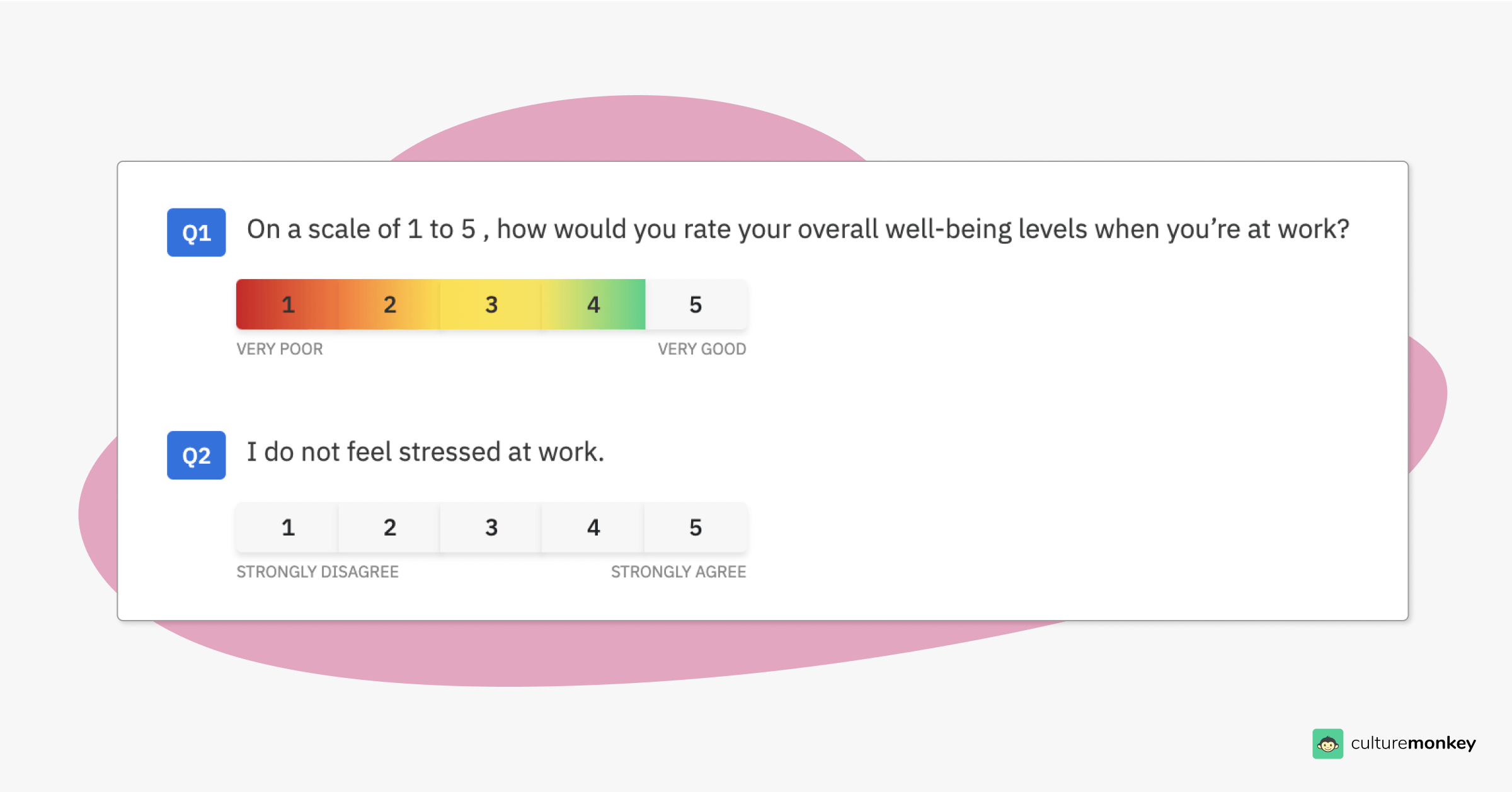
- Sentiment analysis: CultureMonkey’s sentiment analysis uncovers employee emotions and trends in responses, helping leaders detect and address mental health issues early. This ensures a supportive environment and long-term well-being improvements.
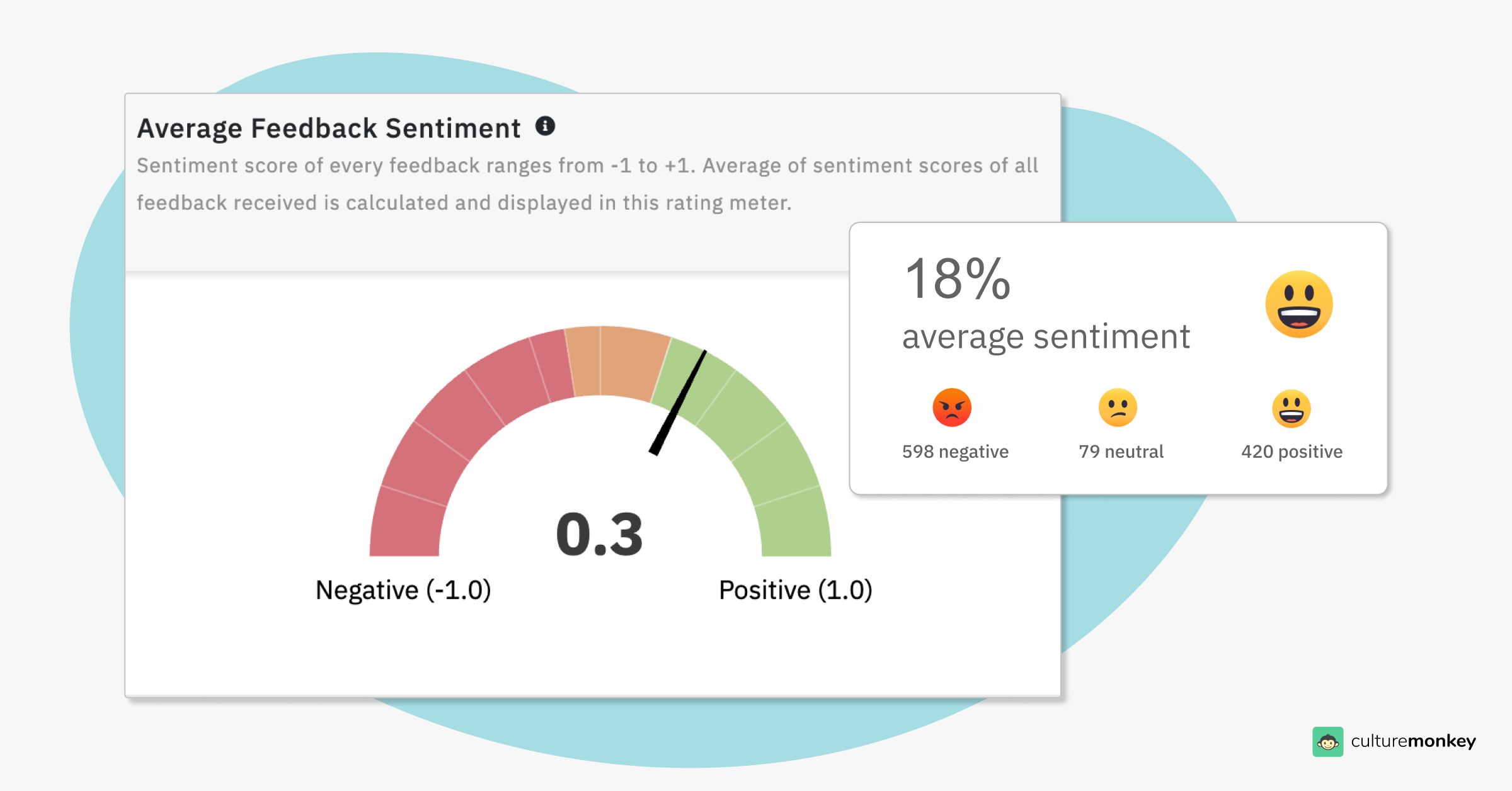
- Action recommendation: CultureMonkey’s AI-driven recommendations provide tailored plans from survey data, helping leaders address mental health challenges effectively for sustained workplace improvements.
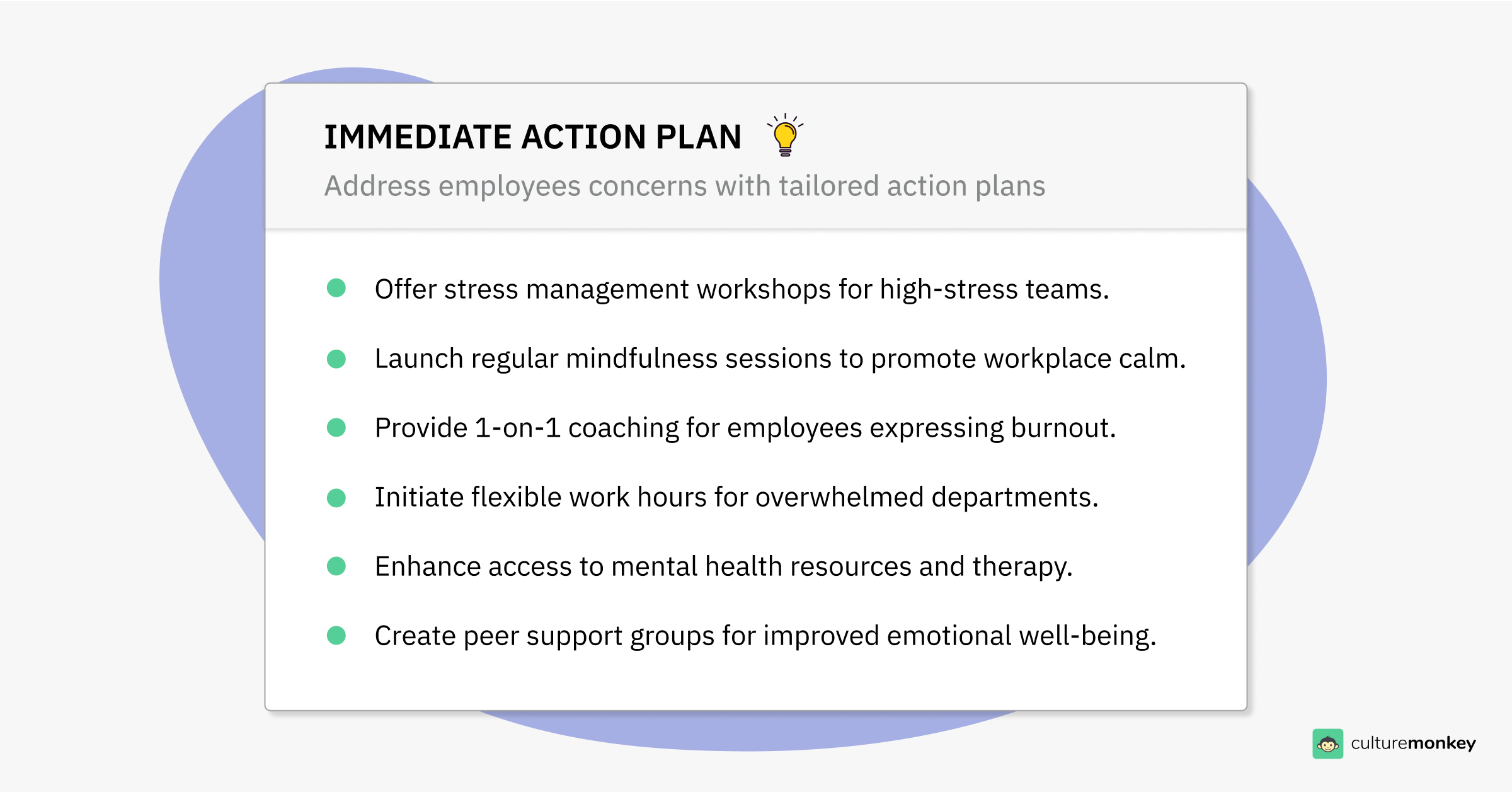
Conclusion
Employee mental health has become a central concern for organizations striving to create supportive and productive cultures. Poor mental health can lead to stress, anxiety, and burnout, which in turn harm overall job satisfaction and performance. Regularly assessing mental health through surveys enables companies to better understand the challenges their employees face and implement strategies to address them.
The mental health survey tool emerges as the optimal choice among the various methods available. It's not just about asking questions; it's about fostering a culture of care and prioritizing the well-being of your workforce.
CultureMonkey stands out as a valuable platform in this space, offering a comprehensive solution to gauge employee well-being. CultureMonkey values privacy and anonymity, ensuring that employees can express themselves candidly. This creates a safe space for open dialogue and empowers organizations to tailor support programs to individual needs.
CultureMonkey’s mental health survey tool delves deep into the minds and hearts of employees, providing a holistic understanding of their mental health. The tool's well-crafted questions cover aspects of support, communication, work-life balance, stress management, and overall mood, painting a comprehensive picture of employee well-being.
Summary
Mental health in the workplace is essential for fostering engagement, productivity, and overall organizational success. Addressing mental health challenges like poor communication, low engagement, and stress helps improve decision-making, collaboration, and customer relations.
Proactively supporting mental health can reduce absenteeism, turnover rates, and legal risks. Promoting well-being also enhances team dynamics, leadership, and creativity. Organizations that focus on mental health reduce operational costs and foster loyalty among employees by creating an inclusive, supportive culture.
FAQs
1. How often should mental health surveys be conducted?
Mental health surveys should ideally be conducted quarterly to capture regular insights into employees' well-being. This frequency allows organizations to identify trends and intervene before issues escalate. However, depending on the workplace environment and specific needs, bi-annual or annual surveys may also be appropriate. Consistency is key to tracking progress and making data-driven decisions to improve workplace mental health.
2. How can mental health survey questions help in improving workplace well-being?
Mental health survey questions help identify stressors, areas of concern, and overall well-being among employees. By gathering this data, organizations can implement targeted interventions, such as wellness programs or workload adjustments. Additionally, these surveys foster open communication, showing employees that their mental health is valued, which can lead to increased engagement, productivity, and a healthier, more supportive work environment.
3. How can anonymity be ensured when conducting mental health surveys?
Anonymity in mental health surveys can be ensured by using third-party platforms or anonymized data methods. Avoid asking for identifiable information like names or department details. Implement secure, encrypted systems for survey responses to protect confidentiality. Clearly communicate that responses are anonymous, fostering trust and encouraging honest feedback, which is essential for accurate workplace well-being assessments.
4. How can mental health survey questions be tailored for different workplace environments?
Tailoring mental health survey questions involves considering the specific challenges and dynamics of each workplace. For example, remote work environments may focus on isolation or communication issues, while high-pressure industries might address burnout. Engage with employees and leadership to understand the unique stressors present and customize questions accordingly, ensuring they resonate with the specific environment and provide actionable insights.
5. How should an organization address negative feedback received through mental health surveys?
When addressing negative feedback from mental health surveys, organizations should respond promptly and transparently. Acknowledge concerns raised, and communicate a clear action plan to address them. Engage in follow-up discussions with affected teams or individuals to better understand their issues. Implement necessary changes and monitor the impact, ensuring employees see that their feedback results in tangible improvements to workplace well-being.
6. How long does the mental health survey take to complete?
The employee mental health survey typically takes 5–10 minutes to complete. It includes a mix of mental health survey questions for employees, psych evaluation questions, and elements from a mental wellness questionnaire. Designed for efficiency, this mental health questionnaire for employees offers valuable insights without overwhelming participants.
7. How does this survey support workplace well-being initiatives?
By using well-crafted mental health in the workplace survey questions, the survey helps identify stressors, communication gaps, and support needs. The workplace mental health questionnaire also includes mental health discussion questions and mental evaluation questions, providing a foundation for data-driven well-being programs tailored through employee mental health questionnaire insights.
8. How often will these mental health surveys be conducted?
Most organizations conduct an employee mental health survey quarterly or bi-annually. Regular check-ins using questions about mental health in the workplace, mental health research questions, and the mental health in the workplace questionnaire ensure timely support. The goal is to maintain ongoing dialogue and adapt strategies through recurring mental health questionnaire for employees cycles.
9. Why should companies ask mental health survey questions?
Companies should ask mental health survey questions to better understand employee wellbeing, identify early signs of stress or burnout, and create a supportive work environment. These surveys promote open communication, reduce stigma around mental health, and help leaders take proactive steps to improve engagement, productivity, and retention by showing employees that their emotional wellness truly matters.
10. What should we do with mental health survey results?
After collecting mental health survey results, analyze the data to identify trends, pain points, and areas for improvement. Share anonymized, high-level findings with your team to maintain transparency. Most importantly, take meaningful action based on feedback—whether it’s adjusting workloads, improving support systems, or offering mental health resources. Regularly communicate updates to show employees their input drives real change.




